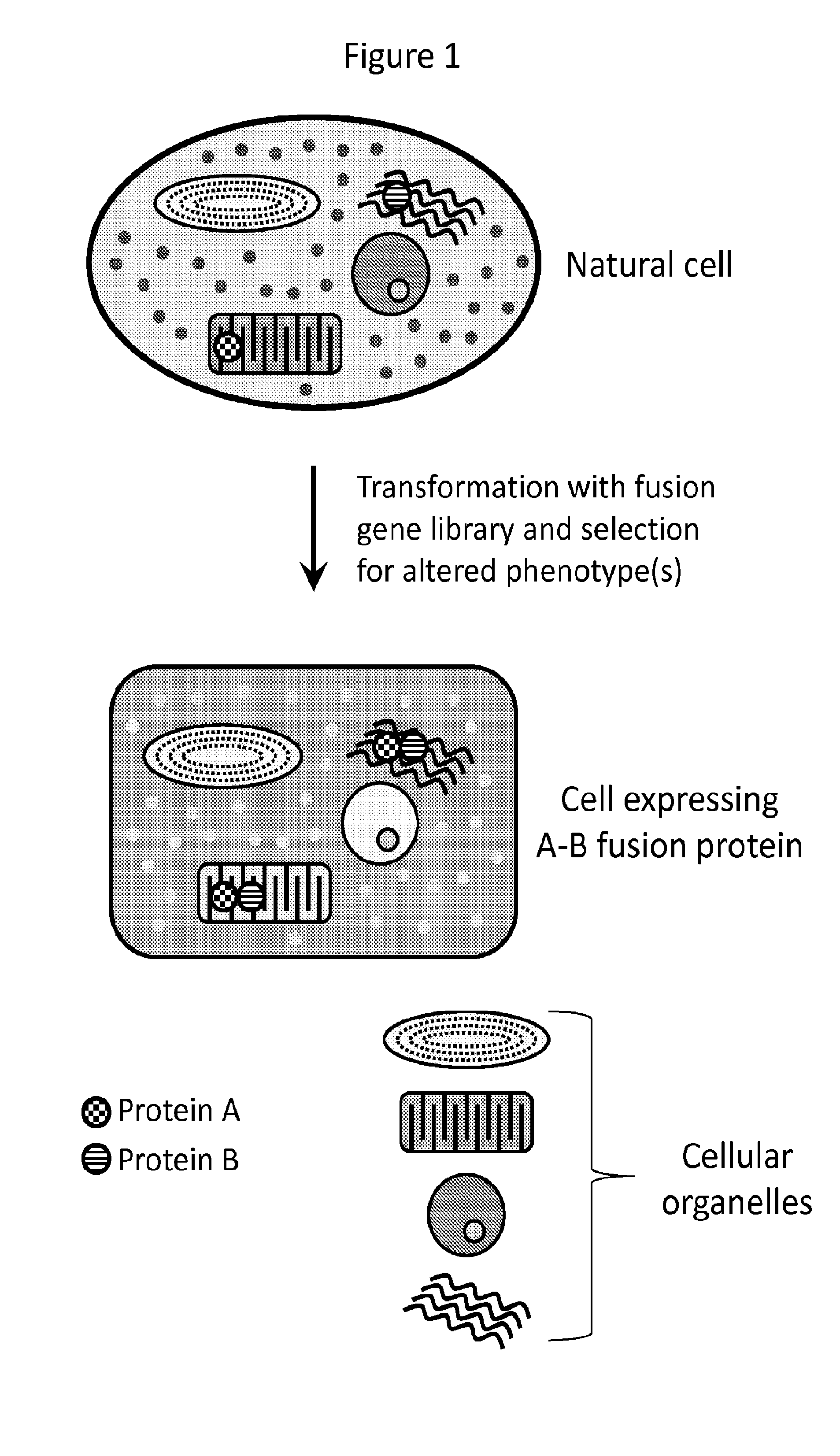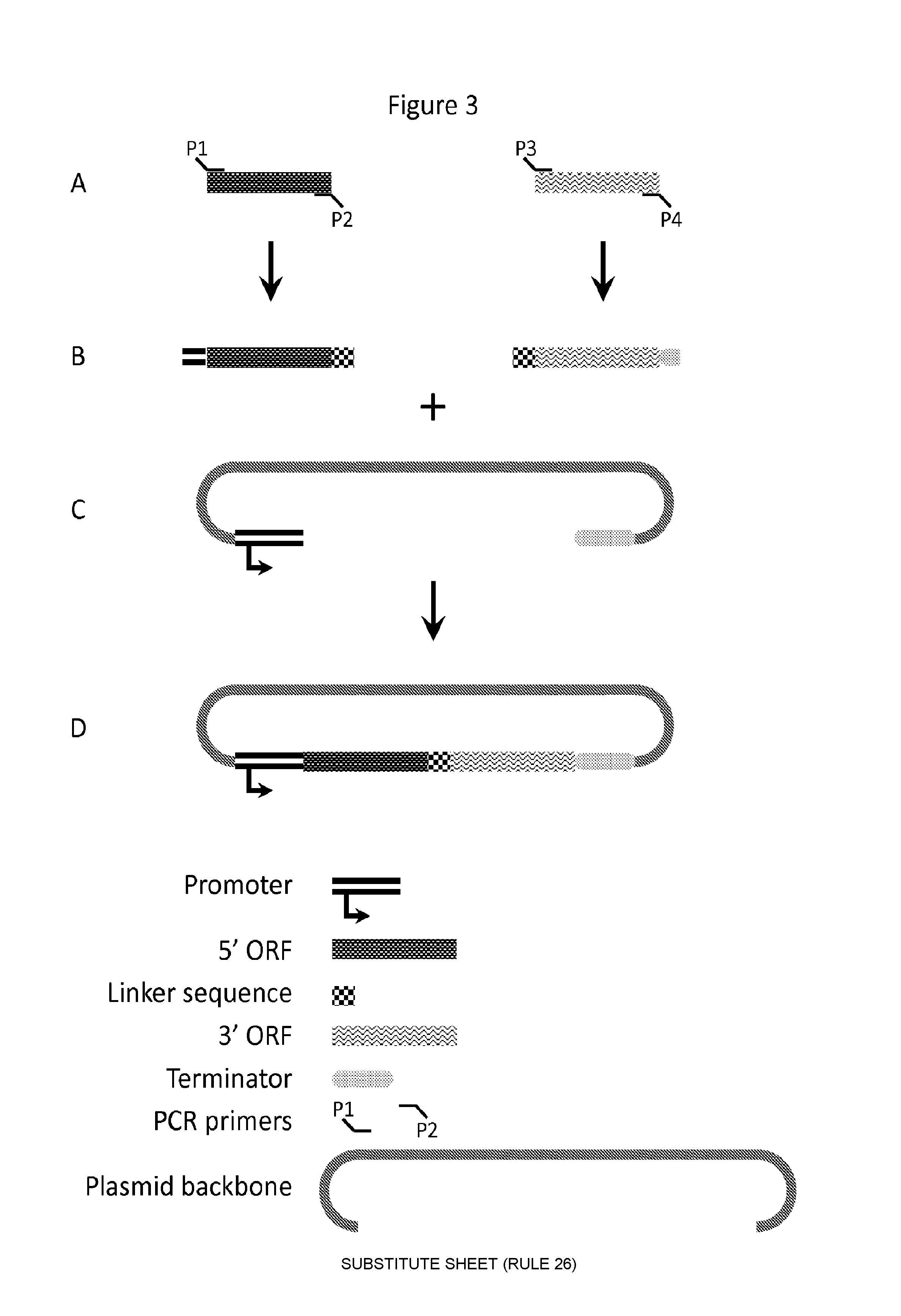Compositions and methods for creating altered and improved cells and organisms
a technology of cells and organisms, applied in the field of compositions and methods for creating altered and improved cells and organisms, can solve the problems that no attempt has been made to take advantage of the function-generating capability of fusion genes or polypeptides in a large-scale and systematic manner, and achieve the effect of increasing diversity within populations and new characteristics of transformed cells or organisms
- Summary
- Abstract
- Description
- Claims
- Application Information
AI Technical Summary
Problems solved by technology
Method used
Image
Examples
example 1
Isolation of Randomized in-Frame Fusion Polynucleotides Capable of Conferring Stress Tolerance to Escherichia coli
Bacterial Strains and Genomic DNA Preparation:
[0059]A complete collection of E. coli ORFs is generated based on the reference sequence of E. coli strain K-12 MG1655 (available on the internet via the genome section of the University of Wisconsin website). This strain is available from the American Type Culture Collection (ATCC), and is used as a source of high-purity genomic DNA from which ORFs of interest are amplified. A sequence annotation of this genome is used to identify the start and stop codons of each ORF. For example, one particular annotation prepared by the J. Craig Venter Institute (available from the cmr-jcvi website on the internet) lists a total of 5,286 protein-coding ORFs, including both verified and hypothetical protein-coding genes, ranging in size from 93 bp (encoding 31 amino acids) to 7152 bp (encoding 2384 amino acids).
[0060]The length of genes u...
example 2
Isolation of Randomized in-Frame Fusion Polynucleotides Capable of Conferring Heat, Salt, UV and Butanol Tolerance to Saccharomyces cerevisiae
[0118]Product tolerance traits of production microbes are important factors that contribute to maximal yields and titers of fermentation products (Ding 2009, Jia 2009, Dunlop 2011). The ability of a microbe to resist and continue to grow in the presence of toxic compounds is genetically complex, dependent on a large suite of genes in multiple pathways (Liu 2009, Dunlop 2011). Previous efforts of engineering product tolerances in bacteria, cyanobacteria and yeasts have met with mixed success (Alper 2006, Tomas 2003, Atsumi 2010, Dunlop 2011a, Liu 2012, Tian 2013). Resistance traits are inherently difficult to create, and some of the resulting resistant strains suffer from lower yields (Baer 1987, Zhao 2003, Atsumi 2010). This compounds the complexity of the problem and underscores the need for a pipeline of solutions for product tolerance, tha...
example 3
Isolation of Randomized in-Frame Fusion Polynucleotides Capable of Conferring Higher Biomass, Accelerated Growth Rate or Alcohol Resistance to Cyanobacteria i.e. Synechococcus elongatus
Introduction:
[0184]Cyanobacteria have been engineered to produce a variety of chemicals, including ethanol (Deng 1999, Dexter 2009, Gao 2012), isobutyraldehyde (Atsumi 2009), isobutanol (Atsumi 2009), n-butanol (Lan 2011, Lan 2012), 1,3-butanediol (Oliver 2013), acetone (Zhou 2012), ethylene (Takahama 2003), isoprene (Lindberg 2010), fatty acids and fatty alcohols (Liu 2011, Tan 2011) and sugars (Ducat 2011, Ducat 2012), in some cases with promising results (i.e. Ducat 2011, Oliver 2013). Because of their relative genetic simplicity compared to plants and eukaryotic algae, low input requirements for their cultivation, ability to resist stresses, and amenability to genetic manipulation, cyanobacteria are among the photosynthetic organisms that will play a major role in this global shift towards biolog...
PUM
| Property | Measurement | Unit |
|---|---|---|
| pH | aaaaa | aaaaa |
| pH | aaaaa | aaaaa |
| pH | aaaaa | aaaaa |
Abstract
Description
Claims
Application Information
 Login to View More
Login to View More - R&D
- Intellectual Property
- Life Sciences
- Materials
- Tech Scout
- Unparalleled Data Quality
- Higher Quality Content
- 60% Fewer Hallucinations
Browse by: Latest US Patents, China's latest patents, Technical Efficacy Thesaurus, Application Domain, Technology Topic, Popular Technical Reports.
© 2025 PatSnap. All rights reserved.Legal|Privacy policy|Modern Slavery Act Transparency Statement|Sitemap|About US| Contact US: help@patsnap.com



